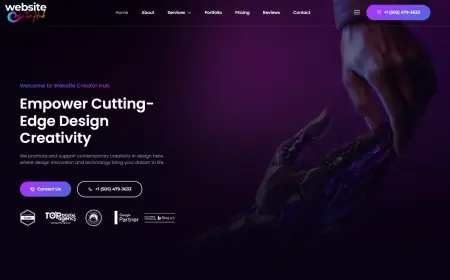How Does AI Development Support Remote Work Trends?
Discover how AI development supports remote work trends by enhancing productivity, collaboration, and employee well-being in 2025.

Remote work has evolved from a temporary necessity to a long-term strategy for businesses worldwide. The rise of remote work trends has reshaped workplace dynamics, creating a need for innovative solutions to enhance productivity and collaboration. Enter artificial intelligence (AI), a game-changer that is revolutionizing how organizations support their remote teams. AI development has enabled the creation of tools that streamline communication, automate repetitive tasks, and ensure efficient project management, empowering businesses to thrive in a distributed work environment.
AI is not only transforming workflows but also addressing challenges like employee isolation and uneven work distribution. With tools like AI-driven chatbots, smart scheduling systems, and virtual assistants, employees can manage their tasks more effectively while staying connected to their teams. Additionally, AI-powered analytics help organizations monitor employee well-being and optimize resource allocation. This synergy between AI and remote work is paving the way for a more connected, efficient, and productive future.
Understanding AI Development
AI development refers to the process of creating systems and algorithms that enable machines to perform tasks typically requiring human intelligence. This includes learning from data (machine learning), understanding language (natural language processing), and making decisions (artificial neural networks). AI development involves designing models that can process large datasets, recognize patterns, and adapt to new information. It requires expertise in mathematics, computer science, and domain-specific knowledge to build systems that are efficient, reliable, and capable of solving complex problems. As AI continues to evolve, it is becoming an integral part of various industries, enhancing productivity, innovation, and decision-making.
AI-Driven Communication Tools
AI-driven communication tools are transforming how remote teams connect and collaborate. These technologies ensure seamless interactions, break language barriers, and enhance productivity. Here are six tools and their impact on remote work:
-
AI Chatbots for Instant Communication
AI chatbots enable instant responses to employee queries, reducing wait times and improving efficiency.
They can be integrated into team platforms like Slack or Microsoft Teams for seamless support.
This ensures quick access to information and minimizes disruptions in workflow. -
Real-Time Language Translation Tools
AI-powered translation tools like Google Translate ensure smooth communication across global teams.
They provide real-time transcription and translation during video calls or text exchanges.
This fosters inclusivity and enhances collaboration among multilingual teams. -
AI-Powered Meeting Transcription Tools
Tools like Otter.ai generate accurate meeting transcripts for reference and follow-ups.
They allow team members to focus on discussions instead of taking notes during calls.
This improves clarity and ensures that no critical points are missed. -
Smart Email Assistants
AI assistants like Grammarly or Boomerang enhance email communication by suggesting tone adjustments and scheduling.
They help draft clear, concise messages, reducing miscommunication.
Automated scheduling ensures timely responses and improves coordination. -
AI-Enhanced Video Conferencing
Platforms like Zoom use AI to optimize audio, video quality, and virtual backgrounds.
Features like automated noise suppression and smart lighting improve call experiences.
This creates a professional and distraction-free environment for remote meetings. -
Sentiment Analysis in Communication Tools
AI tools analyze team communication to gauge mood and sentiment trends.
This helps managers address concerns, maintain morale, and foster a positive work environment.
By understanding team dynamics, organizations can ensure better engagement and productivity.
Enhanced Productivity Through Automation
AI-powered automation tools are essential for boosting productivity in remote work environments. They handle repetitive tasks, streamline workflows, and free up time for more strategic work. Here are six ways AI is enhancing productivity through automation:
-
Automated Task Management Systems
AI-driven tools like Asana or Trello automate task assignments and prioritize workloads.
They track project progress and send reminders to keep teams on schedule.
This reduces manual oversight and ensures that tasks are completed efficiently. -
Smart Scheduling Assistants
AI assistants like Clara or x.ai automatically schedule meetings based on availability.
They can coordinate across multiple time zones, avoiding scheduling conflicts.
This saves time spent on back-and-forth email exchanges, ensuring smoother operations. -
Automated Data Entry and Processing
AI tools like Zapier and Integromat automate the transfer of data between platforms.
They reduce the risk of human error in data entry and improve consistency.
Automation allows employees to focus on high-value tasks while AI handles the routine work. -
AI-Powered Email Management
AI email assistants like SaneBox or Clean Email organize and prioritize inboxes.
They automatically filter spam, categorize messages, and set reminders for follow-ups.
This reduces the time spent managing emails, improving overall work efficiency. -
Automated Reporting and Analytics
AI tools like Power BI or Tableau generate automated reports and visual analytics.
They analyze large datasets and present actionable insights in real time.
This reduces the need for manual data crunching, empowering employees to make quicker decisions. -
AI-Driven Customer Support Automation
AI-powered chatbots handle customer inquiries and provide immediate assistance.
They can resolve simple issues without human intervention, freeing up support teams.
This speeds up response times, enhances customer satisfaction, and boosts productivity.
AI-Powered Collaboration Platforms
AI-powered collaboration platforms are transforming how remote teams work together, making communication, document sharing, and task management more efficient. These platforms leverage AI to streamline workflows, improve real-time collaboration, and enhance productivity. Here are six ways AI is driving collaboration in remote work:
-
Intelligent Document Collaboration
AI tools like Google Workspace or Microsoft 365 enhance document collaboration with real-time editing.
AI auto-suggests content, grammar improvements, and formatting changes for smoother workflows.
These platforms ensure that team members can work together on documents without version conflicts. -
AI-Enhanced Virtual Whiteboards
Tools like Miro or MURAL use AI to suggest layout improvements and content organization.
They help remote teams brainstorm and collaborate visually in real-time.
AI-driven features like auto-shape recognition and smart content placement make collaboration more intuitive. -
Smart File Sharing and Organization
AI-powered platforms like Dropbox or Box automate file categorization and tagging.
They suggest relevant files based on the project, improving accessibility and organization.
AI ensures that team members can quickly find the documents they need without wasting time searching. -
Real-Time Collaboration Insights
AI tools like Slack or Microsoft Teams provide insights into team engagement and project status.
They track communication patterns, identify bottlenecks, and suggest areas for improvement.
These insights help managers optimize team collaboration and resource allocation. -
AI-Driven Task Assignment
AI platforms like Monday.com automatically assign tasks based on team members' availability and skill sets.
They can prioritize tasks according to deadlines, ensuring a balanced workload.
This minimizes the chances of overburdening employees and helps maintain a steady workflow. -
AI-Powered Video Conferencing
Platforms like Zoom or Google Meet use AI to enhance video call quality by adjusting lighting and audio.
They can also transcribe meetings and provide summaries, making it easier for team members to stay aligned.
AI-powered virtual assistants can schedule meetings and send reminders, ensuring seamless collaboration.
Employee Well-Being and Engagement
AI is playing a crucial role in enhancing employee well-being and engagement in remote work settings. By monitoring employee performance, providing personalized support, and fostering a positive work environment, AI helps businesses maintain a healthy workforce. Here are six ways AI contributes to employee well-being and engagement:
-
AI-Driven Employee Feedback Systems
AI-powered tools like Officevibe or TINYpulse collect anonymous feedback from employees.
They analyze responses to identify potential issues related to job satisfaction and engagement.
These insights help employers make data-driven decisions to improve the work environment. -
AI-Powered Wellness Programs
AI platforms like Virgin Pulse or LifeDojo personalize wellness programs for employees.
They track health metrics, offer fitness challenges, and suggest wellness activities based on individual preferences.
This promotes healthier lifestyles and supports employees' mental and physical well-being. -
Sentiment Analysis Tools
AI tools like Affectiva or Empath use sentiment analysis to monitor employee emotions.
These tools analyze communication patterns to gauge mood and stress levels.
They help managers proactively address concerns and maintain a positive workplace culture. -
Personalized Career Development
AI-driven platforms like Cornerstone or LinkedIn Learning recommend personalized learning and development opportunities.
These platforms suggest courses, training, and career paths based on employee skills and interests.
Personalized growth opportunities keep employees engaged and motivated to progress in their careers. -
AI-Powered Mental Health Support
AI chatbots like Wysa or Woebot provide confidential mental health support to employees.
These tools offer coping strategies, relaxation exercises, and stress-relief techniques.
By providing immediate support, AI helps reduce burnout and promotes emotional well-being. -
Workload and Stress Monitoring
AI tools like RescueTime or Time Doctor track employees' workload and stress levels.
They analyze working patterns to identify potential burnout risks and suggest improvements.
These platforms help employers balance workloads and ensure employees' mental and physical health are prioritized.
Overcoming Challenges with AI
AI has the potential to address various challenges in remote work environments, such as communication barriers, workload management, and employee engagement. By automating routine tasks, AI reduces the cognitive load on employees, allowing them to focus on more strategic work. Additionally, AI-driven tools help improve collaboration, enhance decision-making, and provide real-time insights into team performance. However, challenges like data privacy, employee resistance to change, and integration with existing systems must be addressed. With the right implementation and support, AI can transform remote work, creating more efficient, productive, and balanced work environments.
Future Trends in AI and Remote Work
As AI continues to evolve, its integration with remote work will shape the future of how teams collaborate, communicate, and stay productive. The next wave of AI-driven innovations promises to enhance efficiency, security, and employee experience in the remote work environment. Here are six future trends in AI and remote work:
-
AI-Enhanced Virtual Reality (VR) Workspaces
AI-powered VR platforms like Spatial or Horizon Workrooms will create immersive, collaborative virtual environments.
These workspaces will allow remote teams to interact in a more lifelike, engaging way.
VR workspaces will improve collaboration, reduce isolation, and provide a sense of presence for remote workers. -
Advanced AI Chatbots for Seamless Communication
Future AI chatbots will become more advanced, offering natural, human-like conversations.
These chatbots will be able to understand context, emotions, and intent to provide personalized responses.
This will streamline communication and help employees find information faster without human intervention. -
AI-Powered Personal Assistants for Work-Life Balance
AI assistants will help employees better manage their work-life balance by automating personal and work-related tasks.
These assistants will schedule meetings, prioritize tasks, and even suggest breaks to prevent burnout.
They will become essential tools for managing both professional and personal life in a remote work setup. -
AI-Driven Talent Acquisition and Recruitment
AI will further automate recruitment processes by analyzing candidate profiles and predicting the best fits for roles.
Tools like HireVue and Pymetrics will use AI to assess candidates' skills, personality traits, and cultural fit.
This will improve the efficiency of hiring and ensure companies select the best talent remotely. -
AI for Predictive Workforce Analytics
AI will analyze employee data to predict performance trends, turnover risks, and engagement levels.
These predictive insights will allow companies to take proactive steps to improve employee satisfaction.
AI-driven analytics will ensure a data-backed approach to workforce management and decision-making. -
AI-Enhanced Cybersecurity for Remote Work
As remote work expands, AI-powered cybersecurity tools will become essential for protecting sensitive data.
AI will detect anomalies, monitor network traffic, and provide real-time threat detection and response.
These tools will help ensure that remote work environments remain secure, minimizing cyber threats.
Conclusion
The integration of AI in remote work strategies is no longer optional but essential for organizations aiming to remain competitive. By automating routine tasks, enhancing communication, and providing actionable insights, AI empowers employees to focus on creative and strategic aspects of their roles. Moreover, AI's ability to analyze large volumes of data ensures that businesses can make informed decisions about workforce management, project timelines, and resource allocation.
As remote work trends continue to evolve, AI development will remain at the forefront of innovation, offering new tools and technologies to address emerging challenges. From improving employee engagement to fostering a collaborative virtual environment, AI is shaping the future of work. Businesses that embrace this transformation will not only adapt to the remote work era but also set new benchmarks for efficiency and success.
What's Your Reaction?
 Like
0
Like
0
 Dislike
0
Dislike
0
 Love
0
Love
0
 Funny
0
Funny
0
 Angry
0
Angry
0
 Sad
0
Sad
0
 Wow
0
Wow
0















































